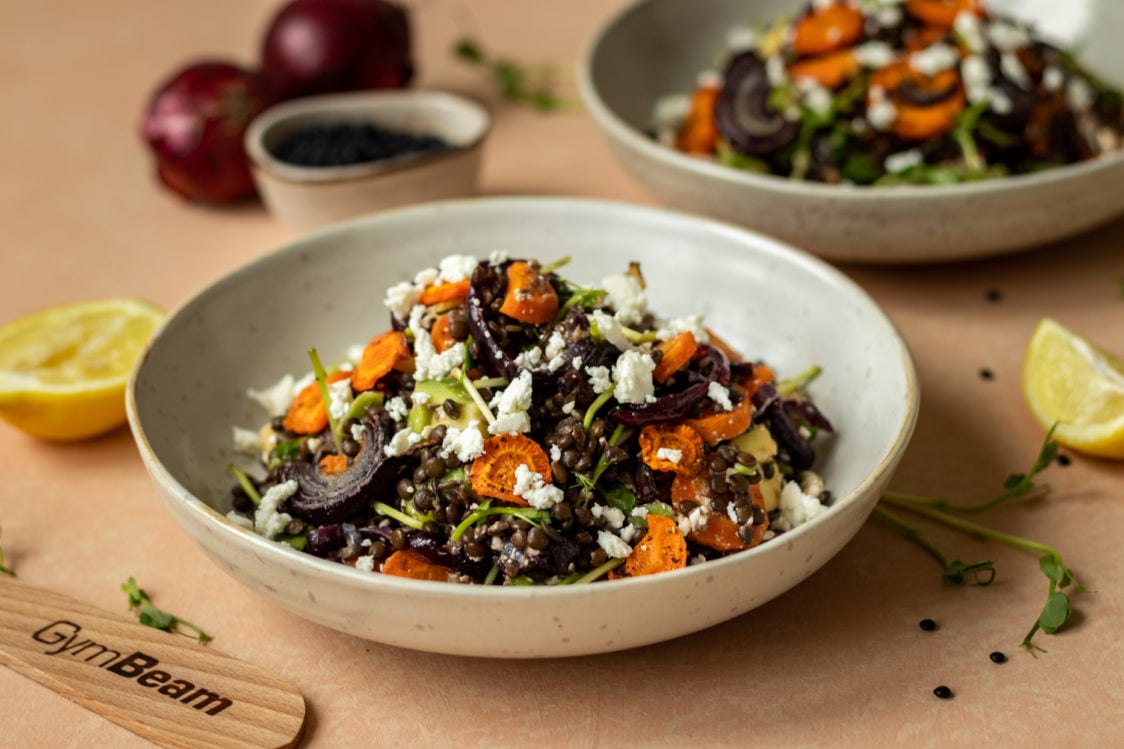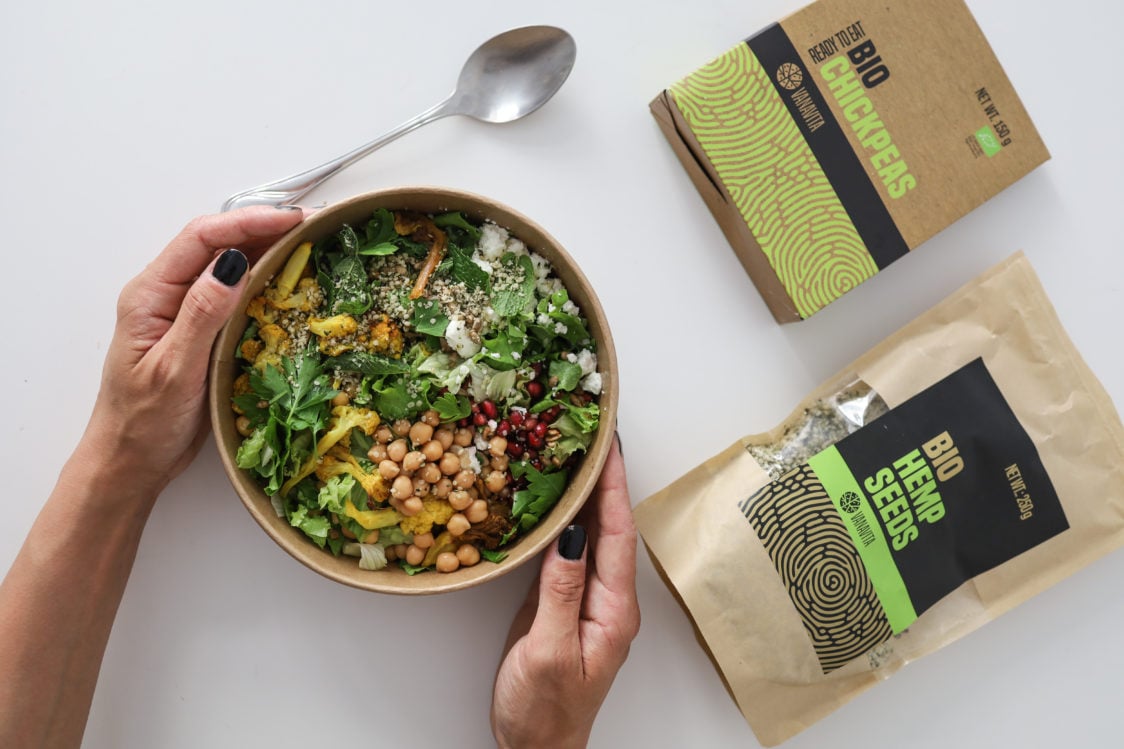Table of Contents
Whether you’re losing weight, gaining muscle, or just want to stay healthy, sufficient protein intake is crucial. After all, it’s present all throughout the body and it would be difficult to find processes in which it isn’t involved. That’s why it’s a shame that high-quality protein-rich foods are often considered enemies of your wallet.
It is true that their prices are climbing upwards and it can be quite financially demanding to regularly have salmon, beef steak or good Dutch cheese for dinner. However, these foods are the top of the pyramid. Under it, you can find a large number of those that don’t have to destroy your financial situation. In today’s article, you will find tips on which foods to buy so that you don’t have to neglect your protein intake.
How much protein do you need per day?
Recently, food prices have risen noticeably, and it’s hard not to get shaken up. More and more often you have to consider what to buy in a supermarket and what is no longer worth it. Animal foods, which are the best source of protein, are usually among the first ones to be left on the shelf due to their price.
However, achieving your goals won’t work without optimal protein intake. For example, an active person who also participates in strength sports needs approximately 1.4-2 g of protein per kg of body weight per day. For a woman weighing 70 kg, this represents 98-140 g of protein per day. If you are also trying to lose weight, it is recommended to increase your protein intake to 1.6-2.4 g/kg. [21]
Fortunately, there are differences in the price of protein-rich foods, and if you focus on the more affordable ones, you can put together a proper menu with a sufficient amount of protein at an affordable price. If you want to understand the importance of protein for your body, read our article Protein: Its Functions in the Body, Recommended Intake, Food Sources and Deficiency Symptoms.

Foods with a high protein content
1. Chicken
Let’s not kid each other, eating meat every day is not exactly the cheapest thing to do. However, it is one of the foods that helps easily supplement protein. After all, on average, 100 g of chicken meat contains up to 20 g of protein. From a regular serving, which is about 150 g, you can get about 30 g of protein. For someone, this amount could represent almost a third of their daily protein requirement. [17]
Even if it doesn’t seem like it, chicken meat is certainly one of the most affordable options. You just need to know how to do it. The price of chicken breast itself is not what it used to be. But have you considered buying a whole chicken and cutting it up at home? If you compare the price of a whole chicken and, for example, a chicken breast per 100 g of meat, you will find that you can easily get the unportioned chicken for half the price. This way you will get 2 breasts, 2 wings, 2 thighs and bones for a soup, and you will also save quite a bit.
What other nutrients does chicken contain?
Chicken meat is good not only because of the protein content, but also from the point of view of the amount and composition of fat. Overall, it has a low amount of fat, which is why it’s also suitable for weight loss. Chicken breasts contain the smallest amount of fat, approx. 2.6 g/100 g. The fattest are chicken wings, which have around 13 g/100 g. You also shouldn’t forget about the fact that there is a difference between eating meat with and without the skin. The skin increases its fat content by up to 25-30%. [10]
Further advantage of chicken meat is its fatty acids content. Compared to other sources, it contains a considerable amount of monounsaturated and polyunsaturated fatty acids. They have a positive effect on the cardiovascular system and overall health. In addition to healthy fats, chicken meat is also rich in, for example, phosphorus, zinc and B vitamins. [10]
Approximately how much energy and nutrients does chicken contain?
Chicken Breast (100 g) | Chicken Wings (100 g) | Chicken Thighs (100 g) | |
|---|---|---|---|
| Energy Value | 115 kcal | 187 kcal | 116 kcal |
| Protein | 23 g | 17.5 g | 20 g |
| Fat | 2.6 g | 13 g | 4 g |
| Carbohydrates | 0 g | 0 g | 0 g |
Tired of constantly eating stir-fried chicken breast with rice? Get inspired by our recipes that can help to spice up your menu.
- Try preparing, for example, chicken breast in orange sauce.
- Get some nice spicy aroma in your kitchen and have indian curry with shredded chicken for lunch.
- Baked yogurt-marinated chicken breast can also spice up your boring lunch routine.
- You can also try ready-made meals such as Italian-style chicken with pasta or chicken curry with rice.

2. Canned tuna
Similar to meat, fish also ranks first in protein content. However, if you want to follow the general recommendations and eat 1–2 servings of fresh fish every week, you’d have to dig deep into your pockets. Fortunately, there are more affordable options in this food group as well.
Fresh tuna steak is not one of them, but if you reach for the canned one, you can enjoy it for much less money. You can choose from tuna in brine, or, for example, in vegetable oil. These alternatives are similar in price, but tuna in brine is usually even cheaper due to the price of the oil itself. From 100 g of tuna, you get an average of 20-25 g of protein.

What other nutrients does tuna contain?
When choosing canned tuna, in addition to the price and taste, many people also appreciate its fat content. Tuna is naturally a low-fat fish. Tuna in brine contains only up to 2 g/100 g of fat. However, in vegetable oil, the fat content per 100 g can rise to approximately 20-30 g. In addition, the amount of fat is different for each brand, so it is important to read product labels.
And which version is better? It depends on your goals:
- If you are trying to lose weight, you will definitely benefit more from tuna in brine.
- If your goal is just a varied diet, tuna in oil can also be a good choice.
In addition, tuna has a relatively high amount of vitamin D, up to around 6 µg/100 g. The daily recommended intake is 15 µg (recommendation of the European Food Safety Authority, EFSA). It is also a good source of vitamin A or vitamin B12. [5,17]
In connection with fish, there is also talk about their mercury contamination. Tuna is one of the larger fish and is thus more susceptible to this. However, if it’s part of a varied diet, rather than eating it for every meal, you certainly don’t have to worry about the side effects. You also don’t have to be worried about heavy metals found in canned food. Cans are treated in such a way that these substances do not leak into the food contained in them. [1,8]
How much energy and nutrients does tuna contain?
Tuna in Brine (100 g) | Tuna in Oil (100 g) | |
|---|---|---|
| Energy Value | 100 – 120 kcal | 170 – 400 kcal |
| Protein | 20 – 25 g | 20 – 25 g |
| Fats | 0.50 – 1 g | 4 – 35 g |
| Carbohydrates | 0 g | 0 g |
Even such an ordinary food as canned tuna can be turned into a great meal. You don’t have to rely only on tuna pasta salad.
- You can prepare a delicious tuna wrap.
- You might also like this tuna egg spread.
- If you’re looking for something a bit exotic, prepare an unconventional poké bowl.
- A good snack could be, for example, a tuna salad with bread.
3. Sardines
Fortunately, there’s no need to limit yourself in such a healthy food group as fish, even if you have to control your spending. Sardines are also a relatively cheap source of protein. As in the case of tuna, they are readily available in canned form, whilst 100 g contains roughly 18-25 g of protein. One 125 g can of sardines thus contains 22-31 g of high-quality proteins.
Again, the price of each version can vary, but usually, for the already mentioned reasons, sardines in brine are cheaper.
What other nutrients do sardines contain?
Compared to tuna, sardines are richer in fat. Even those in brine contain around 8 g of fat per 100 g. Also, don’t forget that the fat content of sardines naturally varies depending on the season in which they were caught. This fat is then, of course, part of the juice, which, together with the sardines, makes up the contents of the can. As a bonus, sardines caught in summer have a smoother taste due to the fat they accumulated.
If you decide to go for sardines in oil, be aware that their fat content can reach up to 30 g. However, this varies by brand and product, so be sure to read the packaging.
However, a higher fat content does not automatically mean a worse food. Sardines, like other sea fish, are rich in polyunsaturated fatty acids, including omega-3, which are important for the function of the brain and heart. [19,22]
In addition to healthy fats, they are also a good source of vitamin D, vitamin B12, and selenium, which acts as an antioxidant in the body. Calcium, which is beneficial for our bones, is also definitely worth mentioning. Canned sardines contain plenty of it, especially in their bones. Therefore, it’s not a bad idea to eat them whole. [22]
How much energy and nutrients do sardines contain?
Sardines in Brine (100 g) | Sardines in Oil (100 g) | |
|---|---|---|
| Energy Value | 140 – 200 kcal | 180 – 370 kcal |
| Protein | 17 – 29 g | 18 – 25 g |
| Fats | 7 – 9 g | 12 – 33 g |
| Carbohydrates | 0 g | 0 g |
You might be interested in these products:
4. Eggs
It would be hard to find a more nutritious food than eggs. They contain a wide range of different vitamins, minerals and other bioactive compounds and are also a great source of high-quality protein. An average egg contains approximately 7 g of it. For example, one serving of an omelet made from three eggs can provide you with up to 21 g of protein. [17]
What other nutrients do eggs contain?
In eggs, fat goes hand in hand with protein. Most of it can be found in the egg yolk, which contains about 5 g of fat. People who are trying to lose weight should bear this in mind, because the three-egg omelet from earlier could easily add 15 g of fat to their daily intake, which could be a quarter of their recommended daily intake. If you want to get the protein from eggs, but you’d like to keep it low-fat, you can also buy egg whites alone. An omelet from 100 g of egg whites can give you up to 22 g of protein, while the amount of fat will be almost zero (but of course, this will increase a little if you prepare them in oil). [17]
However, the fat in eggs is largely composed of unsaturated fatty acids, which are healthy. There was once a claim that the cholesterol in eggs increases blood cholesterol levels, but it doesn’t seem to be the case.
The content of favourable nutrients of eggs certainly doesn’t end with fat and protein. They are rich, for example, in fat-soluble vitamins, such as vitamin D, A or vitamin K. Furthermore, they are also a good source of biotin, which contributes to the proper functioning of the nervous system and the maintenance of healthy hair. They even contain a significant amount of folic acid, which is typical especially for plant foods and is necessary, for example, for the proper development of the fetus during pregnancy.[14,19]
The article 10 Reasons to Eat Eggs will tell you more about this topic and the content of other nutrients.
How much energy and nutrients do eggs and egg whites contain?
Egg Whites (100 g) | ||
|---|---|---|
| Energy Value | 138 kcal | 49 kcal |
| Protein | 12.5 g | 11 g |
| Fats | 9.5 g | 0.2 g |
| Carbohydrates | 0.7 g | 0.7 g |
It is quite easy to include eggs in your diet and you don’t have to stick to just omelette or scrambled eggs.
- Prepare a tasty egg spread.
- Use them to prepare, for example, savoury muffins.
- You can also add them to savoury oatmeal.
- Furthermore, eggs are used to prepare various pancakes, crepes or for baking a delicious dessert.

5. Quark
Dairy products are good sources of protein in general. However, if you want to look at it from the price-performance point of view, quark takes the first place. 100 g of quark contains roughly 9-12 g of protein, while the fat-free quark has the most protein of them all. What’s even better is that it’s usually the cheapest one as well.
Quark is quite unique in its casein protein content. Unlike whey proteins, casein proteins are digested and absorbed more slowly, which is why quark is often consumed as a source of slowly digestible proteins before going to bed. [4]
What other nutrients does quark contain?
Quark is a good source of calcium, which is absolutely necessary for the formation of bones and teeth, transmission of nerve signals and many other functions. It contains 70-100 mg/100 g, while the daily recommended intake for a healthy adult is 1000 mg. Unlike plant sources, calcium from dairy products is very well absorbable. [4]
How much energy and nutrients does quark contain?
Fat-Free Quark (100 g) | Semi-Skimmed Quark (100 g) | Full-Fat Quark (100 g) | |
|---|---|---|---|
| Energy Value | 69 kcal | 90 kcal | 131 kcal |
| Protein | 12 g | 10 g | 9 g |
| Fats | 0,5 g | 3.8 g | 9 g |
| Carbohydrates | 4 g | 4 g | 3.5 g |
How to incorporate quark into your diet?
- For example, add some variety to your sweet breakfast toasts.
- Have it in the form of a poppy seed quark cake.
- Prepare a quark dessert in a glass.
- By mixing quark, sardines, onion, mustard, salt and black pepper, you can create a tasty sardine spread.

6. Greek yogurt
Unlike classic plain yogurt, Greek yogurt boasts a larger amount of protein. While classic white yogurt has 4 g of protein per 100 g, Greek yogurt has up to 10 g/100 g. A breakfast consisting of 150 g of Greek yogurt, granola and fruit can provide you with at least 15 g of protein.
The higher protein content of Greek yogurt is due to the way it is produced, when part of the liquid whey is removed from classic yogurt. The yogurt then becomes thicker and more concentrated. Twice as much milk is used for its production compared to classic yogurt. [3]
What other nutrients does Greek yogurt contain?
Like quark, Greek yogurt is also rich in calcium. It contains up to 110 mg per 100 g. It is also a source of vitamin B12 or vitamin B2 (riboflavin), which is needed for functional energy metabolism, nervous system or skin health. [17,19]
How much energy and nutrients does Greek yogurt contain?
| Energy Value | 57 kcal | 100 kcal |
| Protein | 10 g | 8.4 g |
| Fats | 0.3 g * | 5.3 g * |
| Carbohydrates | 3.5 g | 4.6 g |
*Fat content may vary. It depends on what kind of milk the yogurt is made from.
7. Tofu
Even if you prefer plant-based protein sources or like using them to diversify your diet, there are relatively cheap alternatives for you too. One of them is tofu, a product made from soy milk. This food contains approximately 12-16 g of protein per 100 g (depending on the production method). In contrast to animal proteins, plant-based proteins are generally considered incomplete (they do not contain all essential amino acids in optimal amounts), but soy comes close to animal foods in terms of amino acid content.
Tofu can be purchased unflavoured, with herbs, smoked or, for example, marinated. However, from the price perspective, unflavoured tofu is the most affordable choice. You can then flavour it and prepare it at home according to your own preferences.
What other nutrients does tofu contain?
Apart from being high in protein, tofu is also a good source of calcium. However, it depends on what substance is used to precipitate soy proteins during its production. If calcium salts are used, it contains double the amount (approx. 680 mg of calcium) compared to a product that is produced in a different way (approx. 350 mg of calcium). [17]
Approximately how much energy and nutrients does tofu contain?
| Energy Value | 140 – 170 kcal |
| Protein | 13 – 17 g |
| Fats | 9 – 10 g |
| Carbohydrates | 2 g |
At first glance, tofu is not the most attractive food. However, you can prepare it in countless ways. How to learn to like tofu?
- Use it to make a tasty spread with sun-dried tomatoes.
- Use it for a tortilla wrap.
- Add it to your pancake batter.
If you are interested in other plant-based foods that can replace meat, read our article Plant-Based Meat Alternatives: Which Are the Best, How Much Protein Do They Contain, and Can They Fully Replace Meat?

8. Legumes
When looking for suitable protein sources, one cannot overlook legumes. They contain up to 20-25 g of protein per 100 g, and it would be hard to find a cheaper food. However, pay attention to their nutritional profile. Legumes do not contain all essential amino acids in sufficient quantities, and are therefore not a complete source of protein. In reality, this means that they are not optimally used in the body for the creation of body proteins. However, if you also add some animal foods in your diet along with them, you don’t have to worry. If you are vegan or if plant-based food is prevalent in your diet, make sure you also eat enough grains, possibly nuts and seeds. By combining legumes and cereals, you will receive the right amino acids in the right ratio. [4,17]
Lentils
Lentils belong to legumes with the highest protein content. They contain approximately 26 g of protein per 100 g. A bowl of lentil soup with 50 g of lentils provides you with approximately 12 g of protein. If you add, for example, a piece of rye bread (approx. 9 g of protein), you can get roughly 21 g of protein with an optimal composition of essential amino acids from one serving.
You can replace classic brown lentils with red or black. You can also get the benefits of legumes, for example, from lentil pasta.
What other nutrients do lentils contain?
This type of legume is the richest in iron. Compared to others, it contains two to three times more of it. It’s also a good source of fibre, folic acid, copper, manganese and other bioactive compounds. [4,20]
How much energy and nutrients do lentils contain?
Brown Lentils | |||
|---|---|---|---|
| Energy Value | 319 kcal | 295 kcal | 333 kcal |
| Protein | 26 g | 27 g | 23 g |
| Fats | 1 g | 1 g | 2 g |
| Carbohydrates | 40 g | 29 g | 48 g |
| Fibre | 23 g | 31 g | 16 g |
You can make a tasty soup from lentils, add them to a salad or use them to make vegan spaghetti bolognese.

Chickpeas
Chickpea stands out among other legumes in the content of essential amino acids. Their amount is actually close to animal foods. However, it is still advisable to combine it with other plant sources (cereals, nuts and seeds). [13]
What other nutrients do chickpeas contain?
Chickpeas contain a high amount of folic acid – more than three times the recommended daily intake. In addition, it is a great source of soluble fibre. It has a probiotic effect and has a positive effect on the composition of your gut microbiota. [7]
How much energy and nutrients does chickpea contain?
| Energy Value | 366 kcal |
| Protein | 21 g |
| Fats | 6 g |
| Carbohydrates | 51 g |
| Fibre | 12 g |
You don’t have to eat chickpeas only in the form of hummus. It’s also suitable for salads, as a substitute for meat in paprika sauce or as a base for falafel.

Peas
Even peas are not that far behind in their protein content. They can have up to 23 g of proteins per 100 g. You can also enjoy them, for example, in the form of pea pasta, which contains a similar amount of nutrients. If you then add an animal-based food or grain, you get a great meal with enough complete protein.
What other nutrients do peas contain?
This legume is rich in vitamin B1 (thiamine). It contains up to 0.72 mg, which is around 70% of the recommended daily intake for a healthy adult. Thiamine is necessary for good heart and nervous system function. It is also rich in, for example, magnesium, phosphorus, vitamin K or fibre. [2,17,19]
How much energy and nutrients do peas contain?
| Energy Value | 332 kcal |
| Protein | 23 g |
| Fats | 4 g |
| Carbohydrates | 40 g |
| Fibre | 22 g |
Beans
A diet full of legumes certainly doesn’t have to be boring. On top of the already mentioned lentils, chickpeas or peas, there are plenty of beans to choose from. You can try red kidney beans, black beans, white beans, adzuki, pinto or, for example, mung beans. All of them can provide you with a significant amount of protein, ranging between 20-25 g / 100 g.
What other nutrients do beans contain?
They are rich in fibre, folic acid, vitamin B3 (niacin), potassium, copper, phosphorus, magnesium and many other vitamins, minerals and bioactive compounds. [11]
How much energy and nutrients do beans contain?
Mung Beans | |||||
|---|---|---|---|---|---|
| Energy Value | 314 kcal | 315 kcal | 327 kcal | 315 kcal | 310 kcal |
| Protein | 22.5 g | 21,6 g | 24 g | 21 g | 20 g |
| Fats | 1.1 g | 1.4 g | 1.2 g | 1.2 g | 0,5 g |
| Carbohydrates | 46 g | 46 g | 47 g | 47 g | 50 g |
| Fibre | 15 g | 16 g | 16 g | 16 g | 13 g |
There are countless ways to incorporate beans into your diet.
- For example, turn them into a tasty spread.
- Add them to a salad or a colourful burrito.
- Beans can also be eaten in sweet recipes, for example in bean brownies.
If you want some help with choosing the right plant-based protein source, read our article called What Are the Best Sources of Plant-Based Protein, and why Should You Include Them In Your Diet?

9. Oats
Among cereals, oats are leading in protein content. They have an average of up to 14 g of protein per 100 g, while other types only have around 10 g/100 g. Compared to other cereals, oats also have a better spectrum of essential amino acids. It is still an incomplete protein source, but it is close to legumes in terms of essential amino acids. [9,15,18]
What other nutrients are in oats?
Oats excel in fibre content of up to 10 g/100 g. One 50 g serving can thus cover about a fifth of the recommended daily intake of fibre (the recommended daily intake is 25 g). The fibres specific for oats are called beta-glucans, and they have a proven positive effect on lowering the level of cholesterol in the blood. [6,12,19]
In addition, oats are also rich in potassium, magnesium, folic acid and vitamin E, which acts as an antioxidant in the body. [19]
Approximately how much energy and nutrients do oats contain?
| Energy Value | 363 kcal |
| Protein | 13 g |
| Fats | 6.5 g |
| Carbohydrates | 58 g |
| Fibre | 10 g |
If you are tired of eating oats with yogurt every morning, try something else.
- Cook an interesting oatmeal with cocoa and coffee.
- You can also make a savoury oatmeal, for example with an egg.
- Use oats to prepare pancakes.
If you want to learn more about the effects and benefits of oats, read our next article Oats: What Nutrients They Contain and Why to Include Them in Your Diet.

10. Peanuts and peanut butter
We think of peanuts as nuts, but they are actually legumes. The amount of protein in them is therefore higher than, for example, in almonds or other nuts, around 26 g/100 g. Similar to other plant-based sources, peanuts are not a well-balanced source of protein, because they do not contain the entire spectrum of essential amino acids in optimal quantities. However, they are a great addition to the diet, whether in the form of whole peanuts, peanut butter or peanut oil. [17]
What other nutrients do peanuts contain?
Despite the high protein content, peanuts cannot be treated as legumes. They contain a high amount of fat. There are around 49 g of fat in 100 g of peanuts. Therefore, you shouldn’t indulge in them too much. You can use the same recommendation as for nuts, which is the amount of 1 handful per day, which corresponds to about 30 g of peanuts (however, it depends on your total daily energy intake).
Peanuts contain a high proportion of unsaturated fatty acids, especially oleic acid. They are also rich in vitamin E or vitamin B1 (thiamine), which is an important part of carbohydrate metabolism. They also contain a high amount of potassium, magnesium and phosphorus. [16]
Approximately how much energy and nutrients are in peanuts?
| Energy Value | 593 kcal | 627 kcal |
| Protein | 26 g | 22.5 g |
| Fats | 49 g | 51 g |
| Carbohydrates | 8 g | 17g |
| Fibre | 8 g | 5 g |
Peanuts or peanut butter can also be used to conjure up interesting recipes.
- Make delicious peanut butter and chocolate cookies.
- Add it to oat bars.
Do you want to know more about peanut butter? Our article Peanut Butter: How to Pick the Best One, and What Impact It Has on Our Health has all the answers.

11. Whey and plant-based protein powders
Protein in the form of nutritional supplements, i.e. various protein powders, can also be a regular part of the diet and a source of high-quality proteins. At first glance, it may seem that this product costs a fortune, and you might end up regretting the purchase. However, if you try to calculate how many servings of protein are in one package, you will find that it actually works out pretty cheap.
Whey protein, the most popular and highest-quality protein of them all, is an excellent source of high-quality and easily digestible protein. The most widely used whey concentrate contains 70-80% protein, which means that one 30 g serving will provide you with roughly 21-24 g of protein. Vegans or those who avoid whey protein, for example for health reasons, can choose from plant-based protein powders.
Don’t be afraid to include protein powders in your diet. Here are some ideas for when and how to use them.
- If you struggle to get enough protein from your regular diet.
- Protein powders are also a great help when you need to enrich your food with protein, but you don’t really have any other food to combine it with. An easy way to do this is to mix it, for example, into your breakfast porridge.
- They are ideal to quickly supplement protein after a workout.
- They are handy on the go or when you need some quick protein source.
- They can make your diet more diverse and interesting.
How much energy and nutrients do protein powders contain?
| Energy Value | 370 kcal | 385 kcal |
| Protein | 74 g | 73 g* |
| Fats | 5.6 g | 6 g |
| Carbohydrates | 6 g | 5.8 g |
*The content depends on the type of plant-based protein.
You can read more about the differences in individual protein powders in the article How to Choose the Right Protein for Weight Loss or Muscle Growth?

How much protein and energy do individual foods contain on average?
Now you have an idea about which more affordable foods can help you maintain a sufficient protein intake. The article How to Sneak More Protein into Your Diet offers more tips for increasing protein intake in your diet.
| Chicken Breast | 120 kcal | 22.5 g |
| Chicken Wings | 191 kcal | 17.5 g |
| Chicken Thighs | 121 kcal | 19.7 g |
| Tuna in Brine | 100 – 120 kcal | 20 – 25 g |
| Tuna in Oil | 170 – 400 kcal | 20 – 25 g |
| Sardines in Brine | 140 – 200 kcal | 17 – 29 g |
| Sardines in Oil | 180 – 370 kcal | 18 – 25 g |
| Eggs | 150 kcal | 12.5 g |
| Egg Whites | 50 kcal | 10 g |
| Fat-Free Quark | 67 kcal | 12 g |
| Semi-Skimmed Quark | 90 kcal | 10 g |
| Full-Fat Quark | 130 kcal | 9 g |
| Greek Yogurt | 58 kcal | 10 g |
| Tofu | 145 kcal | 13 – 17 g |
| Lentils | 295 – 333 kcal | 23 – 26 g |
| Chickpeas | 366 kcal | 21 g |
| Peas | 332 kcal | 23 g |
| Beans | 310 – 327 kcal | 20 – 24 g |
| Oats | 363 kcal | 13 g |
| Peanuts | 593 kcal | 26 g |
| Whey Protein | 370 kcal | 74 g |
What should you remember?
Food prices are gradually increasing and, generally, animal foods, which are a good source of protein, are the most expensive. However, after reading today’s article, you can see that there are ways around it. You can choose those foods that are more affordable, whilst still having a sufficient protein intake. You don’t have to neglect meat, fish or dairy products. Moreover, it’s not a bad idea to include some plant-based sources of protein in your diet as they are cheaper and will provide your body with other beneficial nutrients at the same time.
[1] COSTA, L.G. Contaminants in fish: risk-benefit considerations. – https://pubmed.ncbi.nlm.nih.gov/17913692/
[2] DAHL, W.J. et al. Review of the health benefits of peas (Pisum sativum L.). – https://pubmed.ncbi.nlm.nih.gov/22916813/
[3] DESAI, N.T. et al. Sensory properties and drivers of liking for Greek yogurts. – https://www.sciencedirect.com/science/article/pii/S002203021300725X
[4] DUYFF, R.L. Complete Food & Nutrition Guide. . New York: Academy of Nutrition and Dietetics, 2017. ISBN 978-0-544-52058-5.
[5] EFSA PANEL ON DIETETIC PRODUCTS, NUTRITION AND ALLERGIES (NDA) Dietary reference values for vitamin D. – https://www.efsa.europa.eu/en/efsajournal/pub/4547
[6] EFSA PANEL ON DIETETIC PRODUCTS, NUTRITION, AND ALLERGIES (NDA) Scientific Opinion on Dietary Reference Values for carbohydrates and dietary fibre. – https://onlinelibrary.wiley.com/doi/abs/10.2903/j.efsa.2010.1462
[7] EFSA PANEL ON DIETETIC PRODUCTS, NUTRITION AND ALLERGIES (NDA) Scientific Opinion on Dietary Reference Values for folate. – https://www.efsa.europa.eu/en/efsajournal/pub/3893
[8] EMAMI KHANSARI, F. et al. Heavy metals content of canned tuna fish. – https://www.sciencedirect.com/science/article/pii/S0308814604007460
[9] KLOSE, C. - ARENDT, E.K. Proteins in oats; their synthesis and changes during germination: a review. – https://pubmed.ncbi.nlm.nih.gov/22530714/
[10] MARANGONI, F. et al. Role of poultry meat in a balanced diet aimed at maintaining health and wellbeing: an Italian consensus document. – https://www.ncbi.nlm.nih.gov/pmc/articles/PMC4462824/
[11] MULLINS, A.P. - ARJMANDI, B.H. Health Benefits of Plant-Based Nutrition: Focus on Beans in Cardiometabolic Diseases. – https://pubmed.ncbi.nlm.nih.gov/33562498/
[12] PAUDEL, D. et al. A Review of Health-Beneficial Properties of Oats. – https://www.ncbi.nlm.nih.gov/pmc/articles/PMC8625765/
[13] SÁ, A.G.A. et al. Plant proteins as high-quality nutritional source for human diet. – https://www.sciencedirect.com/science/article/pii/S0924224419308994
[14] SEUSS-BAUM, I. - NAU, F. 11 - The nutritional quality of eggs. – https://www.sciencedirect.com/science/article/pii/B9780857090720500112
[15] SINGH, R. et al. Avena sativa (Oat), a potential neutraceutical and therapeutic agent: an overview. – https://pubmed.ncbi.nlm.nih.gov/23072529/
[16] TOOMER, O.T. Nutritional chemistry of the peanut (Arachis hypogaea). – https://pubmed.ncbi.nlm.nih.gov/28662347/
[17] USDA FoodData Central. – https://ndb.nal.usda.gov/index.html
[18] A comparative study of the functionality and protein quality of a variety of legume and cereal flours. – https://onlinelibrary.wiley.com/doi/abs/10.1002/cche.10226
[19] EU Register of nutrition and health claims made on foods (v.3.6). – https://ec.europa.eu/food/safety/labelling_nutrition/claims/register/public/?event=search
[20] Lentils: Nutrition, Benefits, and How to Cook Them. – https://www.healthline.com/nutrition/lentils
[21] Optimal Protein Intake Guide - Examine. – https://examine.com/guides/protein-intake
[22] Sardines Recipe & Nutrition. – https://www.precisionnutrition.com/encyclopedia/food/sardines

